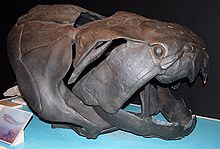Eubrachythoraci is an extinct clade of arthrodire placoderms within the suborder Brachythoraci, armored fish most diverse during the Devonian. Most are considered to be pelagic (open ocean) long-distance swimmers, leading to their widespread distribution beginning from at least the Middle Devonian period.[1]
| Eubrachythoraci Temporal range: Devonian
| |
|---|---|

| |
| Dunkleosteus terrelli skull, Queensland Museum | |
| Scientific classification | |
| Domain: | Eukaryota |
| Kingdom: | Animalia |
| Phylum: | Chordata |
| Class: | †Placodermi |
| Order: | †Arthrodira |
| Suborder: | †Brachythoraci |
| Clade: | †Eubrachythoraci Miles, 1971 |
| Sub-Clades | |
Phylogeny edit
Brachythoraci is divided into the large derived clade Eubrachythoraci and several basal groups: Buchanosteoidea, Homosteidae, and Holonematidae.[1] (Although Holonematidae's membership in Brachythoraci is disputed.)[2]
Eubrachythoraci is then further divided into the sub-clades Coccosteomorphi and Pachyosteomorphi, the latter of which can be further sub-divided into Aspinothoracidi and Dunkleosteoidea,[3] as shown in the cladogram below:[2]
References edit
- ^ a b You-An Zhu; Min Zhu (2013). "A redescription of Kiangyousteus yohii (Arthrodira: Eubrachythoraci) from the Middle Devonian of China, with remarks on the systematics of the Eubrachythoraci". Zoological Journal of the Linnean Society. 169 (4): 798–819. doi:10.1111/zoj12089.
- ^ a b Zhu, You-An; Zhu, Min; Wang, Jun-Qing (1 April 2016). "Redescription of Yinostius major (Arthrodira: Heterostiidae) from the Lower Devonian of China, and the interrelationships of Brachythoraci". Zoological Journal of the Linnean Society. 176 (4): 806–834. doi:10.1111/zoj.12356. ISSN 0024-4082.
- ^ Carr, R.K.; Hlavin, W.J. (2010). "Two new species of Dunkleosteus Lehman, 1956, from the Ohio Shale Formation (USA, Famennian) and the Kettle Point Formation (Canada, Upper Devonian), and a cladistic analysis of the Eubrachythoraci (Placodermi, Arthrodira)". Zoological Journal of the Linnean Society. 159 (1): 195–222. doi:10.1111/j.1096-3642.2009.00578.x.